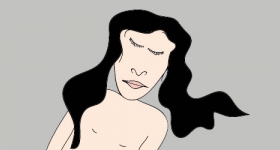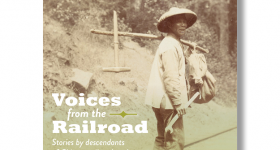Backlit in the window’s bright glare, the string of garlic could’ve been a fistful of flowers, knotted together and hung upside down from a nail in the frame. Each bulb was its own expanding blossom, skin peeling off in concentric circles like translucent petals. I would push a dining chair to the kitchen counter, scramble to my feet, tiptoe around the rice cooker, the knife block, the coffee maker, and pluck peels from the dried-out clusters.
Once Ma found me sprinkling the laminate floor with garlic-confetti — she swooped in, swept me down from the counter. “Makulit,” she called me, pinching my side and removing a sandal from her foot. I bit the knuckles on my right fist so I wouldn’t cry out while she walloped my backside. “Ay sus,” she said, dragging out the last syllable like she always did when she was tired of me, “One day you’re gonna fall off and break your neck, and when you do, I’m gonna feed you to the manananggal.”
I scurried to my room, grateful it wasn’t a spatula or a rolled-up newspaper or one of Pop’s stiff leather belts. Safely burrowed in bed, I rubbed my hands clean of the garlic peels still stuck to my sweaty palms like tiny pearlescent scales.
***
When Ma told me about the manananggal — the vampiric monster who divided her body in half, sprouted wings and flew, hunting pregnant women and little children — I did what most kids did when their mother told them anything: I believed her. I believed in the beautiful lady who went out in the middle of the night and hid the lower half of her split body in the woods. I believed the upper half flew like a bat, her entrails dangling in her wake, and that once she found her prey, she threaded her long tongue through a crack beneath the door or a tear in a window’s mesh screen. I believed its needle-point end pierced slumbering bodies, drained the blood of kids like me and slurped the hearts of unborn babies.
When the streetlights flickered in our neighborhood, I believed she lurked in the shadows or perched on rooftops. I believed she knew about me — makulit American-born Filipina — and that no ocean was vast enough to keep her away. I looked for her over my shoulder when I biked home, bare feet blackened by asphalt. I listened for the swell and beat of her wings outside my window, just beyond my sight.
***
I imagine a mother feels something like grief when her daughter gets her first period. Childhood becomes, more or less, a thing of the past. As with anything marked by closure, perhaps there is a kind of mourning. From there: hips thickening into womanhood, a first cigarette while sitting on the lap of a first boyfriend, cold shoulders and slammed bedroom doors, broken curfews.
I wouldn’t know. She wouldn’t look at me — kept folding the laundry, creasing perfect lines into T-shirts and jeans, gaze dragging heavily from the bin of clean clothes to the neat piles on her bed.
I’d felt a leaking, I told her, found reddish-brown dampness in my panties.
Her long silence shrank the room.
***
I’m no expert on the manananggal, by any means — my understanding of Filipino mythology comes from my mother’s stories and English translations, YouTube clips of horror films and documentaries.
Fact: For nearly 500 years, the Philippine Islands were governed by Spanish colonial rule, and indigenous animistic and polytheistic religious practices were replaced by Roman Catholicism.
Another fact: My mother is at her most Catholic on Sundays, especially Easter Sunday, and Sundays that are also Christmas. She is also the most superstitious person I know.
A theory: The majority of pre-colonial babaylans — Filipino shamans — were women. Their status as liaisons between the spiritual and natural worlds and our perceivable, albeit limited, human reality made them highly respected, valued members of their villages. As Spanish colonizers flayed the land with rosaries around their necks, the babaylans’ commanding presence was, decidedly, a threat. They were ostracized, expelled from the community. Their practices and herbal remedies were unholy. And colonizers, drawing similarities between the babaylan and the manananggal — a creature already dreaded by Filipinos — used fear as a tool for social control. This is an age-old practice men have used and continue to employ when threatened by a powerful woman: make a monster out of her.
When I write into Filipino mythology, I’m reaching for my family. Long-dead matriarchs I’ve never met, aunts and uncles and cousins half a world away. When I write into or out of these narratives, I’m trying to find a pathway back to my ancestors, pre-U.S. military bases, pre-comfort women, pre-colonization. I’m trying to touch a piece of history untainted by white hands.
***
A brief list of tools to ward off the manananggal:
a stingray’s tail, holy water, vinegar, a dagger, something bronze, salt, hintura oil, bolo knives, a needle with a broken eye, onions, a crucifix, reciting a prayer backwards, semen, ginger, loud noises, sunlight, a picture of an old woman, garlic
***
Some months I feel the warm, coagulated blood ooze from my body, and there is relief. Sometimes annoyance — it is almost always poorly timed, and I am almost always unequipped.
But lately, when it comes, I’ve felt something like power brimming from my body, spilling out thick and irrepressible. I strip down to take a shower and a primordial musk fills the bathroom. I carry rubies in my belly; they swirl down the drain, and my body makes more.
And when the pain comes — the pressure deepening in, hollowing out, clawing at my midsection — it feels like being torn apart at the waist.
***
In 1904 at the Louisiana Purchase Exposition (or the St. Louis World’s Fair), 47 acres of land were set aside for a Filipino “living exhibit.” It contained reproductions of ancient structures and villages and was “stocked” with over 1,100 “little brown brothers” from more than 30 different tribes.
Among those populating the exhibit were the Igorots — headhunters from the mountainous region of Luzon, the same region my mother is from. They were forced to butcher dogs and eat them — one of their ceremonial practices of rare occurrence — on a daily basis, while spectators watched and took photos.
Eighty-five years later, my parents and older siblings immigrated to a city in mid-Missouri, a mere two hour drive from St. Louis. My mother was a student. My father, a failed sandwich-maker, then pizza delivery person, then mail carrier, then bus driver, power-washer and diesel mechanic. My brother and sister took ESL classes, wore jelly sandals and garage-sale socks that reached their knees, asked Ma to pack lunches that looked and smelled “normal” so the other kids in school would leave them alone. In history classes, there was no mention of the fair.
In a poem called “Descent,” Luisa A. Igloria writes, “To them I was a stranger, // dark and not to be trusted; my woven skirt a red-striped // carnival tent that might open to what they // could not imagine. …” I found her collection, Juan Luna’s Revolver, as a graduate student and learned — from a two-line epigraph at the start of this poem — what the history books had conveniently forgotten.
***
When I write into Filipino mythology, I’m reaching for my family. Long-dead matriarchs I’ve never met, aunts and uncles and cousins half a world away. When I write into or out of these narratives, I’m trying to find a pathway back to my ancestors, pre-U.S. military bases, pre-comfort women, pre-colonization. I’m trying to touch a piece of history untainted by white hands.
But Tagalog and Ilocano aren’t mine. Filipino history isn’t mine. My sense of what is Filipina is white-washed, filtered through this Western consciousness. I visit my distant cousins and I am a tourist, an embodiment of U.S. imperialism, an outsider who can’t even drink the water. Besides the family nose, all I have are a handful of Ilocano phrases, fragments of stories, a book of myths. The most I can do is preserve the stories that shaped me — the myths passed down by my grandmother, the stories my parents gifted me — and de-mythologize the ones that exploit, that perpetuate stereotypes, that manifest a fake destiny, that pander to white saviors.
***
Every poem I write about my Lola is a way of saying, I love you. We never got to meet when she was alive. I don’t remember her voice, threading through the cord of our landline phone on a long-distance call. She might as well be a myth to me — a few stories from a different world, a figure in a photo who looks faintly familiar.
She died not long after my older brother and sister moved to the States to join my parents. As a kid I thought their leaving made her sick, and I believed it. I believed in a love so unfathomably big, it could only be contained in impossible, paradoxical narratives.
***
Long past my first period, over 10 years since I lived in my hometown, I cook spaghetti. Wet noodles dangle from the holes in the colander and — I can’t help it — I’m reminded of the manananggal, queen of my nightmares, her warm intestines steaming as they drag beneath her severed body. I snort with laughter, call my mother, ask her to finish the story.
She says only women can become a manananggal: A cursed black chick lives in her throat (I laugh a little), and she cannot die until she passes it on. Sprinkle salt on the torn flesh of her lower body and wait for the sun to rise.
The two halves cannot reunite. At dawn, her skin blisters.
I add tomato sauce to the browned ground beef, the tender onions. It begins to churn, to bubble. I roll my eyes, but I am listening. You have to choose it.
You must kiss her, Ma says, so she can transfer the curse into your mouth.
She could writhe in pain forever, if you let her.
Almost always, it goes to the daughter. Who else would take it on?
***
For years, my mother couldn’t sleep through the night. She’d wake when the house was still and move silently to the living room sofa, the basement, or my siblings’ old rooms and read her large-print mystery novels until she’d nod off again.
Who was she in those silent, untouchable moments — no child to tug at her pant leg, no husband to prepare a baon for, no mother to please or disappoint? What shape did her body take?
A few times, I woke to find her asleep beside me, swaddled in her oversized bathrobe on top of the bedcovers. I’d sync my breathing with hers, hold the air in my girl-sized lungs, wait the long fermata for our slow exhale, the low whistling away. I saw the gray roots of her box-dyed hair. Wrinkles fissuring her forehead. Cracked, ashy heels.
One time, as I rose from the bed and maneuvered my body over her legs, holding my breath so I wouldn’t disturb her, she snapped awake. Eyes adjusting to the light, her vision narrowed when my face came into focus. It was as if she didn’t know me, as if she’d breached into this waking world with half her body still dreaming about another life. Not daughter or sister or wife or mother, it seemed, belonging to nothing, to no one —
and a small part of me was hurt by this, and lonely,
and a smaller part in my chest was frightened
and I recoiled beside her ankles,
and the smallest part, from the deepest red of my ancestral blood, said There,
said There you are.










Comments